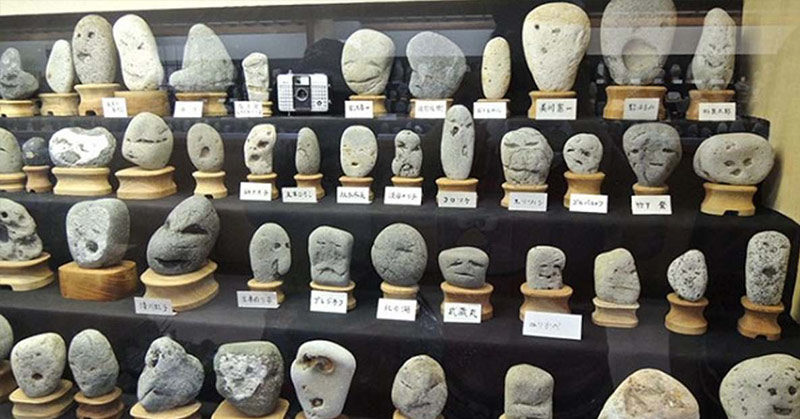For some of us, a geology museum doesn’t sound all that interesting (or maybe it does?). But, a geology museum with a hall of rocks that resemble famous people? Now that’s something to see! The Hall of Curious Rocks in the Chinsekikan museum near Tokyo has just that, and it’s as entertaining as you can imagine.
Chinsekikan Hall of Curious Rocks
It has more than 1700 interesting looking rocks and 900 that resemble famous people and characters, this sounds like a good kind of weird. The museum was founded by Shozo Hayam who had been collecting these rocks for fifty years. After his passing in 2010, his wife Yoshiko has been running the museum. (1)
There a number of famous peoples and characters represented at Chinsekikan, including (1):
- Boris Yeltsin
- Mickey Mouse
- Elvis Presley
- Donkey Kong
- Nemo
- E.T.
- Jesus Christ
- A choir of singers
Though some are more striking than others, all are both impressive and hilarious. Chinsekikan has been featured on several popular TV shows in Japan. (1)
Read: One Of The Few Known Intact Pyramid Capstones In Existence
How the Rocks Are Formed
Just like most things in nature are formed, the rocks were given their unique features over time due to erosion and mineral imperfections. Weathering and cracking frequently occur in rocks, particularly in a sedimentary layer or a point of weakness in the rock. (1)
Some minerals are more affected by the elements than others. Some are delicate and are more likely to erode, while others are more likely to endure. Silicate minerals like micas tend to be more delicate, while others, like quartz, are much more durable. One of the most common causes of rock erosion and natural carvings is flowing water. (1)
Pareidolia
Though the inspiration to start this museum isn’t quite clear, it is thought that Shozo had a certain degree of pareidolia. According to the Merriam-Webster dictionary, this is defined as:
“the tendency to perceive a specific, often meaningful image in a random or ambiguous visual pattern” (2)
Essentially, he would look at the shape of and etchings in rocks and see faces and patterns that other people wouldn’t necessarily see unless prompted.
The Science of Pareidolia
In order to see things, our eyes have to send messages to our brain. Your brain then processes that information to understand what you are looking at. Different parts of the brain are responsible for different stimuli, and they all work together to “decode” the messages they are receiving from your eyes. (3)
Usually, at first, we see what we want to see or what we think is there, which doesn’t always end up being the reality. This is known as Top-down Processing. This is important because it is why our brains tend to search for faces, or familiar features, in other objects. (3)
Face pareidolia is, as you guessed, specifically when we tend to see faces in objects that don’t actually have them. This process is as follows (3):
- The eyes send a message to the brain about what you are seeing.
- This message is sent to the occipital lobe at the back of the brain that is responsible for vision.
- When the message first arrives in the occipital lobe, it is somewhat jumbled up into patterns of light, dark, and edges.
- The brain creates a sort of assembly line that orders these patterns to build a face.
- These parts of faces that have been assembled in the occipital lobe then travel to the temporal lobes behind the ears.
- Here, the information is put together to form one complete package, and your brain then registers that pattern as a face.
The area of the temporal lobe where this all happens is the fusiform face area (FFA). Scientists found that for people who experience face pareidolia, the FFA is active even when they look at a fuzzy or busy picture that they think they see a face in. (3)
Read: Miner to millionaire: Man sells largest-ever Tanzanite gems for $3.3M
Normal or Not?
If you find yourself seeing faces in random objects, don’t worry, you’re not a weirdo. It is actually quite common and perfectly normal to do this. Right from infancy, we learn to recognize and are drawn by faces. This is an evolutionary thing: our ability to spot face-like images helped our ancestors see potential enemies or threats before it was too late. (3)
The Hall of Curious Rocks
Whether you tend to see faces in non-human objects or not, you will find the Chinsekikan museum amusing at a minimum. The next time you’re in Japan, take some time to explore a bit outside of the big city and be sure to stop at this unique place.

